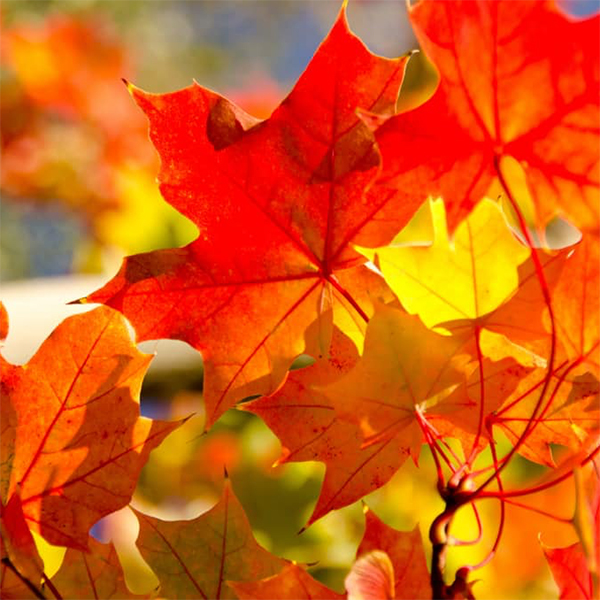
For many New Englanders, autumn is a favorite season—and that’s no wonder, considering the spectacular spectacle offered by our region’s legendary fall color. Red (or Swamp) Maple (Acer rubrum) is native from Texas and Florida, northward to Canada’s Hudson Bay, westward to Minnesota; it’s the State Tree of Rhode Island. It grows naturally in swampy areas, on dry hillsides, in both heavy and sandy soils—a truly adaptable tree, always the first of our native maples to color-up each year to usher-in the fall season.
Few trees can compare with the multi-season appeal and versatility of Acer rubrum—it is called “Red Maple” for good reason. In earliest spring, well before any new growth is visible, this species welcomes the warming days with stunning displays of red flowers that can rival its autumn coloration—that’s the pink-red “wash” we witness in the distant forest in late March and early April that signals spring has begun. This is soon followed by an equally-impressive display of red-to-bronze-colored seeds, often lasting until the tree is fully in leaf in May. Even the twigs and new shoots exhibit colorful reddish tones as they emerge.
All summer Acer rubrum’s leaves are intense green with silvery undersides that seem to sparkle with every breeze. The bark on the trunk and branches is an attractive grey color when young, becoming furrowed, fissured and regal with age. When it grows naturally in forested areas and maple groves it forms a tall specimen, generally reaching 60 feet or more at maturity, taller than wide. In the more open conditions of maintained landscapes it tends to branch lower and spread wider, becoming an impressive specimen. The species grows vigorously and is so resilient that deer damage, insects and plant diseases rarely affect its ability to grow to maturity.
Because it is so reliable and trouble free, the Swamp or Red Maple, Acer rubrum, is one of the favorite landscape trees for this region. When properly sited in your yard, this fast growing tree can also function as an energy saver. Planted on the south side of your home it becomes large enough to provide cooling shade in summer, saving on air conditioning costs; in winter when it is dormant and leafless, it allows winter sunlight to come through to help heat your home. A row or group planting on the north or west of your property can slow winter winds and help reduce home heat loss in winter. And having the attractive seasonal features in your own yard is an added bonus.
Red Maple seedlings are available for landscaping, especially from mail-order nurseries. But growth and fall foliage color can vary widely among plants grown from seed. Selected cultivars and grafted clones with known characteristics are generally offered for sale in garden centers. Some of those commonly available include ‘October Glory’, ‘Red Sunset’, ‘Brandywine’ and ‘Redpointe’, each with somewhat different features.
I’ve noticed that in years like this with adequate moisture, Acer rubrum retains its summer foliage longer, even overlaping with its more celebrated cousin the Sugar Maple (Acer saccharum). Whether you view them in natural areas or in your own yard, we can all appreciate the Swamp Maples as they approach their peak of autumn color.
Note: Don’t be confused by another tree also called “Red Maple” – Acer palmatum atropurpureum, the Japanese Red Maple – this is a much different tree with other growth features (and also well suited for many gardens in this region).
About the Author
Wayne Mezitt is a 3rd generation nurseryman, a Massachusetts Certified Horticulturist, now chairman of Weston Nurseries of Hopkinton, Chelmsford & Hingham MA, and owner of “Hort-Sense”, a horticultural advisory business. He currently serves in various capacities on several horticulturally-related organizations, including the Massachusetts Horticultural Society at The Gardens at Elm Bank in Wellesley MA, and chairman for the Massachusetts Invasive Plant Advisory Group (MIPAG).









